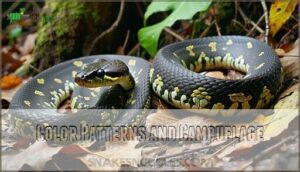This site is supported by our readers. We may earn a commission, at no cost to you, if you purchase through links.

Their adaptability has turned them into one of Australia’s most successful reptiles, thriving everywhere from tropical rainforests to dry rocky outcrops and even city neighborhoods. These non-venomous constrictors can reach lengths over ten feet and weigh more than thirty pounds, yet they move through their diverse habitats with surprising grace.
Understanding carpet python facts reveals how these exceptional serpents balance power with precision, making them both effective predators in the wild and increasingly popular pets for experienced keepers.
Table Of Contents
- Key Takeaways
- Carpet Python Physical Features and Identification
- Natural Habitat and Geographic Range
- Diet, Hunting, and Reproduction
- Behavior, Lifespan, and Pet Care
- Conservation, Ecological Role, and Threats
- Frequently Asked Questions (FAQs)
- How long is a carpet python?
- Where are carpet pythons found?
- What is the scientific name of carpet python?
- Are carpet pythons common in Australia?
- What are some fun facts about carpet pythons?
- Why are they called carpet pythons?
- How bad is a carpet python bite?
- How long do carpet pythons live?
- How do carpet pythons regulate body temperature?
- What is the average cost to own a carpet python?
- Conclusion
Key Takeaways
- Carpet pythons are highly adaptable constrictors found across Australia and New Guinea, thriving in diverse habitats from rainforests to urban suburbs, where they reach lengths over 10 feet and weights exceeding 30 pounds while serving as effective pest controllers by preying on rodents.
- These non-venomous snakes use heat-sensing pits along their jaws to detect warm-blooded prey in darkness, combining ambush strategies with powerful constriction to suffocate their meals, which range from small rodents in juveniles to birds and marsupials in adults.
- Inland carpet python populations face significant conservation challenges, with 40-70% declines over recent decades due to habitat fragmentation, introduced predators like foxes, and human conflict, though most subspecies maintain "Least Concern" status under international protections like CITES Appendix II.
- Captive carpet pythons can live up to 30 years with proper care—10 years longer than wild counterparts—but require specialized husbandry including temperature gradients of 22-34°C, appropriate humidity levels above 40%, and vigilant health monitoring since respiratory infections affect nearly 38% of captive individuals.
Carpet Python Physical Features and Identification
Before choosing an enclosure for your carpet python, it helps to know what makes these snakes unique. Their appearance and physical features can tell you a lot about what they need to feel safe and comfortable.
Let’s walk through the key traits that shape the best home for your python.
Size, Weight, and Body Shape
If you’ve ever wondered just how big a carpet python can get, you’re in for a surprise—these snakes can easily stretch out longer than your couch and tip the scales at over 30 pounds.
On average, adult Carpet Pythons measure about 2–3.6 meters, with scale count and body proportions varying by sex. Males tend to be lighter, revealing sexual dimorphism.
Color Patterns and Camouflage
When you spot a carpet python, it’s hard not to notice the vibrant mix of colors and patterns that help this snake slip through shadows like it’s wearing nature’s own camouflage.
Pattern variation—from olive greens and browns to pale, dark-edged blotches—gives each python its own regional twist.
These snake markings, rooted in genetic basis, boost camouflage effectiveness and reflect evolutionary significance.
Heat-Sensing Pits and Head Structure
While their colors help them blend in, carpet pythons also rely on a set of heat-sensing pits along their jaws to track down a warm-blooded meal in the dark. These features, together with a unique head shape and mobile jaw mechanics, make them expert hunters. Here’s how these snake adaptations support their survival:
- Pit Function: Detects prey heat signatures.
- Scale Arrangement: Protects sensitive pits.
- Sensory Perception: Combines smell, vision, and Jacobsons Organ.
- Jaw Mechanics: Four jaw bones allow wide gapes.
- Head Morphology: Aerodynamic for strike accuracy.
Natural Habitat and Geographic Range
Carpet pythons are experts at making themselves at home in all kinds of environments, from thick rainforests to dry, rocky outcrops. You’ll find them scattered across Australia and up into New Guinea, each population shaped a bit by its surroundings.
Let’s take a closer look at some of the habitats and enclosures these adaptable snakes call home.
Australian and New Guinea Distribution
If you drew a map of Australia and New Guinea, you’d find carpet pythons weaving their way across almost every corner. From island populations in Papua New Guinea to the suburbs of Queensland, these Australian snakes thrive despite habitat fragmentation.
Regional variations reveal how carpet python habitat and range respond to climate impact—making them experts in adapting where many introduced species can’t compete.
Preferred Habitats and Adaptability
From tree branches to sunbaked rocks, carpet pythons have a knack for making themselves at home just about anywhere nature puts out the welcome mat. Whether basking in open woodlands or threading through dense rainforests, their habitat variety is legendary.
You’ll notice their arboreal lifestyle and climate tolerance everywhere—from humid coasts to dusty inland stretches. That’s true carpet python adaptation at work.
Impact of Urban and Rural Environments
In bustling suburbs or open farmland, carpet python habitats tell a story of adaptation and change. Urban adaptation means easier meals from backyard rodents, yet more human interaction. Rural habitats offer traditional cover and wild prey, but face habitat fragmentation. These snakes are known to thrive in various environments.
The ecological impact of snakes in either setting depends on these factors:
- Urban rodent control
- Rural land animal balance
- Habitat fragmentation
- Human-wildlife encounters
Diet, Hunting, and Reproduction
Wondering what carpet pythons eat, how they hunt, and what it takes to bring new snakes into the world? These fascinating behaviors clarify their natural rhythm and needs.
Let’s walk through the basics before you look at your enclosure options.
Typical Prey and Feeding Techniques
Ever wonder what’s on the menu for a carpet python? These snakes aren’t picky eaters—rodents, birds, and even small marsupials top the list, suited to their size and age. Juveniles prefer smaller prey, while adults may tackle larger animals.
Diet varies with hunting seasons, and their impressive digestion process helps them process big meals, reflecting their adaptable snake feeding habits.
Constriction and Ambush Strategies
Spotting a carpet python on the hunt is a bit like watching a master at work—they rely on patience, perfect timing, and silent strength to catch their next meal.
From a hidden ambush location, they track prey with precise sensory input, launch a lightning-fast strike, and use powerful coiling strength to suffocate their prey—a classic example of snake behavior at its best.
Breeding, Egg-Laying, and Incubation
Curious how Carpet Python breeding really works? Here’s what sets them apart:
- Mating behavior heats up in late spring, with females seeking partners.
- After breeding, a clutch size of 10–50 snake eggs appears—each female incubates her eggs closely using maternal care for roughly 60 days.
- Hatching success depends on a stable incubation period, with young carpet pythons venturing out alone. Females use muscle contractions for heat to keep their eggs warm.
Behavior, Lifespan, and Pet Care
Caring for a carpet python starts with understanding how they act and what helps them thrive. Their daily routines, health needs, and personalities all shape the kind of space they require.
Here’s what to think about when choosing an enclosure.
Daily Activity and Arboreal Habits
If you’ve ever wondered what a python does with its day, you might be surprised at just how much of their life unfolds both high above the ground and quietly in the shadows. Carpet pythons show flexible activity patterns, moving both day and night depending on temperature and prey availability. Their arboreal habits mean you’ll often spot them coiled on tree branches, roof beams, or draped across rafters where rodents gather.
These arboreal snakes have adapted remarkably well to human environments, treating suburban backyards like their natural woodland habitats. Their climbing behavior makes them skilled at traversing vertical spaces, which is why you might find one investigating your attic or garden shed. This urban adaptation reflects their adaptability as a nocturnal reptile that thrives wherever food sources exist.
| Time of Day | Primary Activity | Location Preference |
|---|---|---|
| Daytime | Basking, resting | Tree branches, sheltered spots |
| Night | Nocturnal hunting, exploring | Ground level, buildings, trees |
| Urban areas | Opportunistic feeding | Roofs, gardens, chicken coops |
Temperament, Bites, and Non-Venomous Nature
Despite their impressive size and snake-like reputation, carpet pythons are generally mild-mannered and docile, though their curved teeth can deliver a painful bite if they feel startled or threatened.
You’ll find that these nonvenomous snakes rarely show aggression, and their defensive behavior involves fleeing rather than striking. When interactions create risks, it’s usually because you’ve surprised them or they’re feeling cornered.
Their captivity temperament remains calm with regular, gentle interaction, making bite severity more about discomfort than danger.
Lifespan in Wild Vs. Captivity and Health Needs
Beyond their docile nature, carpet pythons exhibit significant variations in lifespan based on their environment. Captive individuals often outlive their wild counterparts by a considerable margin when provided with proper care.
Life span differences and health requirements include:
- Wild Carpet Python populations commonly survive 15 to 20 years, though neonates face up to 70% mortality in their first year from predation and habitat challenges
- Captive longevity reaches 30 years with prime snake care, compared to documented wild maximums near 20 years
- Temperature needs require basking spots at 30–34°C and ambient gradients of 22–26°C, with nighttime lows never below 21°C
- Diet management involves appropriately-sized rodents every 1–2 weeks, with overfeeding risking obesity and metabolic disorders
- Health issues like respiratory infections affect 37.7% of captive pythons, while mite infestations and dysecdysis occur when humidity drops below 40%
Popularity and Responsibilities as Pets
With proper husbandry extending their lives by up to a decade beyond wild norms, carpet pythons have become increasingly sought after in the exotic pet trade—but owning one demands more than enthusiasm.
Snake enthusiasts must understand that responsible ownership includes researching exotic pet laws, investing in secure enclosures, and committing to decades of specialized snake care.
Pet trade ethics matter, so you’ll want to source your carpet python from reputable breeders who prioritize animal welfare over profit.
Conservation, Ecological Role, and Threats
Carpet pythons play a valuable role in their ecosystems, but they also face real challenges that affect their future. Understanding their conservation status, ecological contributions, and the threats they encounter helps you appreciate why these snakes matter beyond their striking appearance.
Let’s look at how carpet pythons fit into the bigger picture of wildlife protection and balance.
Conservation Status and Legal Protections
Globally, carpet pythons hold a reassuring spot on the IUCN Red List as Least Concern, but don’t let that fool you into thinking they’re entirely out of the woods. Australia’s wildlife legislation shields these pythons through multiple layers of protection, and you’ll need a license to keep one legally in any state.
Here’s where conservation status gets complicated:
- Inland carpet pythons in Victoria face an endangered future, with populations dropping 40% to 70% over recent decades due to habitat loss and fox predation.
- CITES Appendix II listing controls international trade, preventing over-collection and ecological imbalances that once threatened wild populations.
- Habitat preservation efforts now target connectivity corridors, with programs like iSPYthon tracking local populations and guiding conservation efforts where they’re needed most.
Environmental policies vary by region, but the message is clear: carpet python conservation status depends heavily on protecting the landscapes they call home.
Role in Controlling Pest Populations
You mightn’t realize it, but carpet pythons are natural pest control experts working quietly in your backyard, roof, or local park. Their diet centers on rodents like rats and mice, which makes them valuable allies in rodent management and maintaining ecological balance.
By hunting mammals that damage crops and spread disease, these snakes provide essential wildlife services. Their predatory behavior bolsters snake conservation efforts, since healthy snake populations naturally regulate pest numbers without chemical intervention.
Major Threats and Conservation Efforts
Across Australia, carpet python conservation faces mounting pressures. Inland populations have dropped 40–70% over 30 to 45 years due to habitat fragmentation, land clearing, and species decline from introduced predators like foxes and feral cats. Human conflict—road deaths and deliberate killing—compounds these threats.
Conservation laws offer protection:
- CITES Appendix II regulates international trade
- Australian states enforce wildlife protection with penalties up to $95,000
- Habitat restoration along the Murray River preserves hollow trees and native vegetation
Community reporting platforms and radio tracking support snake ecology research and animal conservation efforts.
Frequently Asked Questions (FAQs)
How long is a carpet python?
Regarding size, carpet pythons don’t fit a one-size-fits-all mold. These pythons usually measure between 2 and 6 meters in length, though some individuals can reach up to 4 meters—that’s roughly 12 feet.
Where are carpet pythons found?
Carpet pythons inhabit Australia and Papua New Guinea, thriving across diverse environments from rainforests to savannas, rocky outcrops to suburban backyards.
Their geographic range spans northern, eastern, and southern Australia, demonstrating exceptional environmental adaptation to both natural and urban habitats.
What is the scientific name of carpet python?
Scientific nomenclature places carpet pythons in Phylum Chordata, Class Reptilia, and Family Boidae. The primary species identification is Morelia spilota, with taxonomic classification including subspecies like Morelia spilota variegata.
This biological naming system facilitates precise reptile classification worldwide.
Are carpet pythons common in Australia?
These snakes are widespread across northern, eastern, and southern Australia, thriving in diverse environments from rainforests to suburban backyards.
You’ll often find them in Queensland and other coastal regions, where they’ve adapted remarkably well to living near humans.
What are some fun facts about carpet pythons?
Long before smartphones tracked every snake sighting, Carpet Python legends spread through Australia’s outback communities, celebrating these masters of camouflage.
Here are some wild adventures in reptile encounters: their patterns mimic Persian rugs, they’re muscle-bound constrictors averaging 33 pounds, and females shiver constantly while incubating eggs—raising their body temperature without external heat.
Carpet pythons are muscle-bound constrictors with Persian rug patterns, averaging 33 pounds, while brooding females shiver to warm their eggs without external heat
Despite python myths suggesting danger, proper snake management reveals they’re docile pest controllers, not threats.
Why are they called carpet pythons?
The name comes from their intricate scale patterns, which resemble woven carpets or tapestries.
Color variations—olive green, brown, black—blend with diamond shapes, bands, and stripes in lighter hues like cream or gold, creating that distinctive textile-like appearance.
How bad is a carpet python bite?
A carpet python bite isn’t medically serious since these snakes aren’t venomous, but it can be quite painful. Their curved teeth create puncture wounds that bleed and may become infected without proper cleaning. You’ll need to wash the wound thoroughly and monitor healing carefully.
How long do carpet pythons live?
Like a well-oiled machine that just keeps ticking, carpet pythons can reach 20 years in captivity with proper care.
In the wild, their lifespan is shorter due to predators and environmental challenges affecting longevity factors and mortality rates.
How do carpet pythons regulate body temperature?
As cold-blooded reptiles, carpet pythons can’t generate their own body heat, so they rely on behavioral thermoregulation.
You’ll find them basking in sunlight to warm up or retreating to shade when overheated, constantly weaving between warm and cool spots in their habitat to maintain ideal temperature.
What is the average cost to own a carpet python?
Owning a carpet python as a pet involves initial setup costs for an appropriate enclosure or aquarium, ongoing feeding expenses for rodents, and occasional veterinary care.
Long-term costs include heating, lighting, and substrate replacement, making snake care requirements a significant commitment beyond the pet trade purchase price.
Conclusion
These serpents don’t just survive—they thrive where others falter, turning backyards into hunting grounds and trees into fortresses. Understanding carpet python facts means recognizing how evolution crafted a predator that bends the rules without breaking them.
Whether you’re safeguarding your property, caring for one responsibly, or simply respecting their role in Australia’s ecosystems, these pythons remind us that adaptability isn’t luck—it’s mastery. They’ve earned their place in both wild landscapes and human consciousness, proving that success belongs to those who refuse to stay grounded.
- https://www.iucnredlist.org/search?query=Morelia%20spilota&searchType=species
- https://www.blueletterbible.org/search/preSearch.cfm?Criteria=Matthew+10.16&t=NKJV
- https://tooheyforesteec.eq.edu.au/support-and-resources/teacher-resources/coastal-carpet-python
- https://community.morphmarket.com/t/subspecies-interbreeding/10319
- https://capronparkzoo.com/animal-collection/carpet-python/













